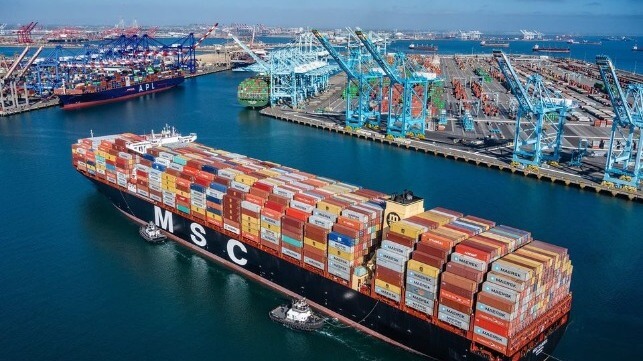Los Angeles has Record January as Steps Continue to Address Congestion

While recording the busiest January in the Port of Los Angeles’ 115-year history, port and state officials continued to report progress in reducing the congestion that was choking the supply chain during the fourth quarter of 2021. In addition, both the port and California detailed further initiatives that they believe will continue to enhance the southern California ports’ ability to handle the continuing surge in import volumes.
Highlighting a better than three percent increase in volumes, Los Angeles Port Executive Director Gene Seroka said the port was off to a strong start to 2022 surpassing not only the high volumes of a year ago but also exceeding January 2019 when shippers were rushing to move cargo before the pending tariff deadlines being imposed by the Trump administration. In January 2022, the Port of Los Angeles moved 865,595 TEU.
Port officials pointed to continuing strong consumer demand as well as shippers’ efforts to move goods before an early lunar new year and the pending shut down of factories and services during the holiday celebrations in Asia. However, the biggest contributor was the continued push to move empty boxes with empties being the only part of the volume that was up year-over-year. The Port of Los Angeles moved 21 percent more empties in January 2022 than a year earlier. Import volumes were down more than two percent over the exceptional volumes a year ago. Exports continued their “abysmal slide down,” said Seroka highlighting that they not only were down 16 percent year-over-year but for 35 of the last 39 months.
Among the issues the Port of Los Angeles highlighted as the continuing challenges was a dramatic increase in extra loaders, vessels added by carriers beyond the schedules. More than a quarter, or 24 of the 87 vessels at the Port of Los Angeles during the month, had been added to the carriers’ schedules. Seroka further highlighted that many of these vessels were smaller ships with a capacity of under 5,300 TEU, which he said still required the dock space and labor while moving fewer boxes. The trend for carriers to add smaller ships to their routes began in the second half of 2021 and is continuing.
Currently, vessel traffic however is down in part possibly due to the lunar new year celebrations. The Marine Exchange for Southern California reported yesterday that a total of 74 containerships were heading to the twin ports with 69 slow steaming in the Pacific. This is down by more than a third from the record of 109 containerships waiting to enter the ports on January 9.
Among the progress points that are being highlighted is a decline by nearly a third of the number of empties at the port. Currently, they reported that there are still 64,000 empty TEU stacked at the port saying they continue to monitor daily the movement and volume of empties. So far, the port however has not imposed the financial penalties they said they were considering either on long-term empties or for dwell time of import containers. Port officials believe that the potential to impose those fees has already contributed to the decline in empties and strong improvements in dwell time. On dock dwell times are down on average to five days from a peak of 11 days in Q3 2021.
As a further step to help with the congestion at the ports, California announced that it has leased state lands to a national warehouse marketplace called Chunker. They leased the land, which provides space for up to 20,000 TEU, for one year with an option for a second year. Chunker will coordinate between the California ports, shipping/trucking companies, and cargo owners to help move containers and free up needed space.
The Port of Los Angeles also highlighted other inefficiencies that it says it is focusing on to further enhance operations. Seroka pointed out that more than half the available truck gates are going unused as is a third of rail capacity. He said the port is working with the companies as these would be areas that could further enhance port efficiency along with improved data flow that they will be introducing in February for tracking operations across the port.
The Port of Los Angeles expects that the volumes will continue strong into 2022. After the lull around the lunar new year celebrations, they forecasted that volumes will be strong into the second quarter as retailers work to replenish supplies and meet the continuing strong consumer demand.
